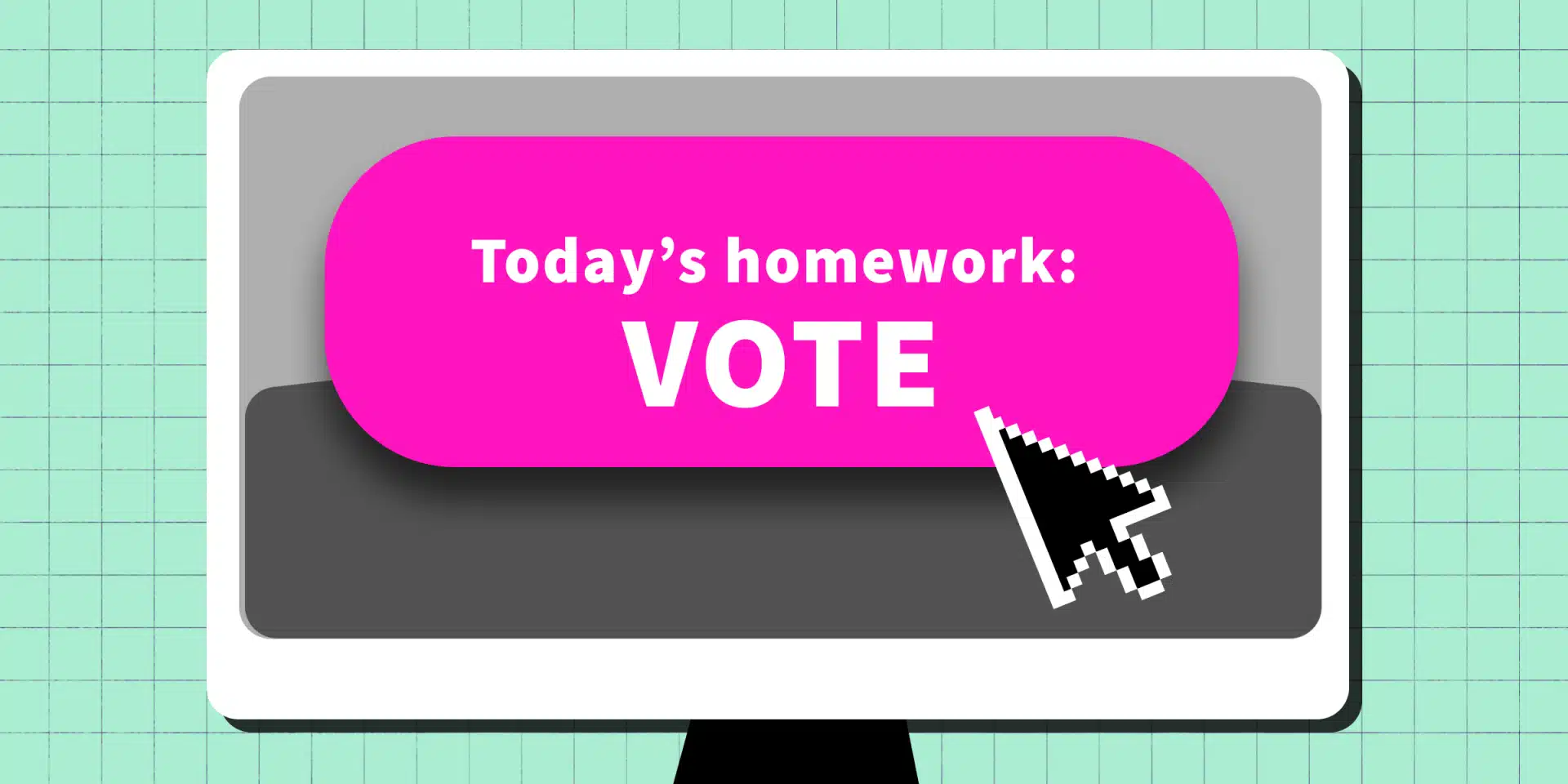Election Day in the U.S. is just around the corner. On top of carrying multiple academic and employment responsibilities, some students will also be voting for the first time. Others, such as those from marginalized or historically underrepresented populations, may be overwhelmed with what the election results could mean for them. In the lead up to Election Day, a healthy dose of empathy will be essential in ensuring students have a chance to fulfill their civic duty—and the opportunity to consider its consequences.
Being flexible with due dates, considering students’ wellbeing and ensuring learners are armed with the resources needed to vote are the most important things you can do as Election Day nears. Read on to learn how professors advocated for their students during the 2020 election—and how you can do the same.
Consider making November 4 and 5 free of assignments (or even classes)
Exams can cause some students a great deal of stress and anxiety. Lillian Horin, Biological and Biomedical Sciences PhD student at Harvard University, urges educators to keep BIPOC students in mind when scheduling high-stakes tests.
Professors: PLEASE don't schedule examinations for directly after election night. In 2016, I had a biochem exam the day after the election. BIPOC students spent our election night begging our professor to postpone it. It intensified one of the most traumatic nights of our lives.
— Lillian Horin 🏳️🌈🧫🔬 (@LillianHorin) August 12, 2020
Consider swapping your exams or problem sets (Psets) with a trip to the ballot box. Jacob Light, Economics PhD student at Stanford University, writes that this simple gesture may allow students to exercise their civic duty.
In 2012 my linear algebra professor canceled our election week problem set because voting was more important. The gesture meant the world to me. Today I made the same argument on behalf of my students. #AcademicTwitter cancel psets during election week; your students want to vote
— Jacob Light (@jlight_) October 13, 2020
Other students like Anna-Sophia Boguraev, Bioengineering PhD student at Harvard Medical School and MIT, say that TAs have the power to amplify student concerns and requests—none of which should be ignored.
legit if you have any leverage w prof, use it to help students – when ppl started basically being like “we’re traumatized plz let us reschedule the midterm” on piazza, the TAs just deleted the posts w no response or acknowledgement bc the prof told them to. so like … not that
— Anna-Sophia (she/her) (@artisanna01) October 3, 2020
If your assignments can’t wait, build in flexibility and timeliness
Self-paced learning can allow students to visit the polls and complete coursework at a time that works for them—so says Jesse Fox, Associate Professor of Communication at Ohio State University.
US instructors: working on your syllabus?
— Jesse Fox (@CommFox) July 29, 2020
🇺🇸Election Day is Tuesday, November 3🇺🇸
Please plan an asynchronous option that day. There are already enough efforts to impede & suppress voting!
Tell a friend! #AcademicChatter #AcademicTwitter #Election2020
Election Day can also be a good opportunity to let students catch their breath in your course. Give students a chance to study and review material that they haven’t had a chance to look over, suggests Scott Grunow, Instructor in English and Religious Studies at the University of Illinois at Chicago.
Same here. Kind of. They are working asychronously on an essay. Feedback week. No synchronous class. I will be available all week for drop in hours.
— Dame Scott G. Against Petty Persecutions/Vainglory (@scottgr60613) October 6, 2020
Should your institutions provide little leeway in your assessment choices, at least incorporate real-time events into your discussions. Derek Bruff, Associate Director, Center for Teaching Excellence at the University of Virginia, notes that relating course content to the election can help students see the value of what they’re learning.
What are you planning to do in class the day after the election? 1. Find a connection to your course topic (e.g. polling error in a stats course). 2. Acknowledge that it was a late, emotional night. 3. Don't give a pop quiz.
— Derek Bruff (@derekbruff) October 15, 2020
Real-time political events and policy proposals can make for discipline-specific conversations. This also allows students to apply what they’ve learned in your class to the real world, as Andrea Gomez Cervantes, Assistant Professor in the Department of Sociology at Wake Forest University, proposes.
To encourage students' critical thinking this election season I included assignments to analyze proposed policies by 2020 candidates.. Could be a great or terrible idea. We will find out! #AcademicTwitter #Sociology #Election2020 #Politics #Families #Immigration
— Dra. Andrea Gomez Cervantes (she/ella) (@AndreaGC_soc) September 23, 2020
Mobilize your students to show up at the polls
Gen Z students are motivated to vote. In the 2018 midterm elections, the student turnout rate increased by 20 percent compared to the 2014 midterms.1 Ensure students are equipped with the resources to vote as soon as possible, writes Wendy Christensen, Sociology Professor at William Paterson University.
Don't forget to include voting info in your Fall 2020 syllabus and online course module! Include any voter registration deadlines, registration info, drop off ballot info, AND the general election date Nov. 3rd. #GOTV #AcademicTwitter @AcademicChatter #AcademicTwitter
— Wendy Christensen 🏳️🌈🦉📚🍺 🏃♀️ (@wendyphd) August 19, 2020
Similarly, ask students about their voting plans. Consider working with your class to ensure they know where to go on November 5, suggests Margaret Boyle, Associate Professor of Romance Languages and Literatures at Bowdoin College.
Hey #AcademicTwitter, is election day on your syllabus? Have you asked your students about their plan to vote? #VoteLoud pic.twitter.com/B6mkUJ9yEc
— Margaret Boyle (@profmargboyle) September 24, 2020
Ensure your voter registration information and resources appeal to all students, regardless of what political party they support. Meghan Novisky, Assistant Professor of Criminology at Cleveland State University, emphasizes the importance of using non-partisan guidelines.
Suggestion for this fall: include (non-partisan) voter registration info for students in week 1's course materials AND inform students election week will be assignment free in support of voter turnout. #phdchat #AcademicChatter
— Dr. Meghan Novisky (@DrNovisky) August 13, 2020
Some scholars like Sara Wheeler-Smith, Associate Professor of Management at Manhattan College, even plan to offer a grading incentive for visiting the polls.
With my chair’s approval, I’m offering extra credit to anyone who can demonstrate they voted. (Anyone ineligible can do an alternative assignment). If I were teaching on #ElectionDay I would have cancelled too.
— Dr. Sara Wheeler-Smith (@svaaati) August 17, 2020
Incorporate guest lectures and learn from your colleagues
Navigating election week with students in mind might be an unfamiliar undertaking. Consider leaning on faculty at your institution for support, writes Heather Mayer, Director of Educational Technology at Everett Community College.
Interested in hearing what people have planned. We’re developing a faculty workshop for the the week before to give people a chance to talk with each other about ideas and resources.
— Heather Mayer (@hmayerpdx) October 6, 2020
Some students may be undecided voters, while others may have missed the presidential debates. Incorporate forms of debate in your classroom—with the support of scholars from other institutions, as Yujin Jung, Political Sciences PhD student at the University of Missouri, plans to do.
I am truly lucky to have political campaign debate seminar with Prof. @MSMcKinney this semester given this exciting political arena – it feels like debate matters even more in this year's election. #AcademicTwitter #PoliticalCommunication https://t.co/63nN9ICum6
— Yujin Julia Jung (@YJuliaJung) October 8, 2020
Keep in mind the importance of mental and physical health
Check-ins with students have gained new meaning in the midst of an election. Andrea Kelley, Sociology Professor at the University of Michigan, tends to her students’ socioemotional needs before assigning readings and lectures.
I have built "self-care" weeks into all 3 of my courses during election week. No new readings, no graded assignments, just a check-in. We can't self-care our way out of structural oppression and related stresses, but I can make sure my classes don't pile on. #AcademicChatter
— Andrea D. Kelley, Ph.D., MSW (they/she) (@adkelleysoc) October 9, 2020
Election Day can come with a range of emotions for many students. Cate Denial, Distinguished Professor of American History, Chair of the History department, and Director of the Bright Institute at Knox College, removes the expectation for students to pay attention and participate in class.
I will not be assigning reading for the week, and instead we'll review whatever happens in light of what we've been learning. It will be completely on the fly, but I will not be expecting my students to be able to focus.
— Cate Denial (@cjdenial) October 6, 2020
References
- Thomas, N. et al. (2018). Democracy Counts 2018: Increased Student and Institutional Engagement. Tufts University. https://idhe.tufts.edu/sites/default/files/DemocracyCounts2018.pdf


